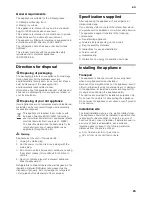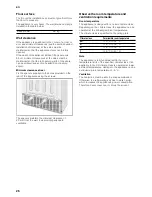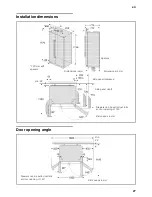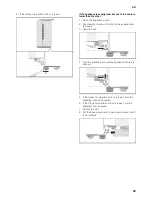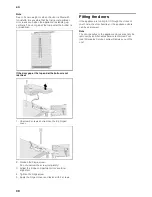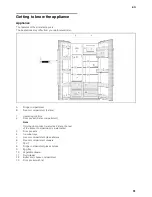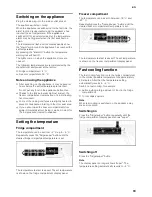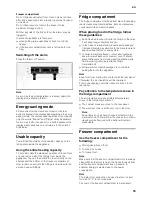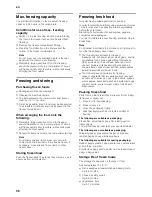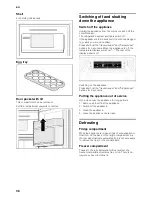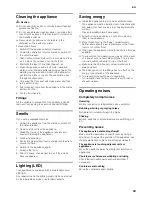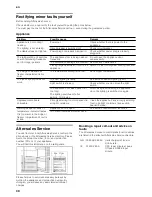
en
39
Cleaning the appliance
m
Caution
Do not use gritty, acidic or chlorine-based cleaning
agents or solvents.
Do not use abrasive cleaning pads or sponges that
may scratch surfaces. This may lead to corrosion of
the metallic surfaces.
Never clean the shelves or containers in the
dishwasher. The parts may warp.
Proceed as follows:
1. Switch off the appliance before cleaning.
2. Unplug the appliance from the mains or switch off
the circuit-breaker.
3. Take out the food and store it in a cool place. Place
an ice block (if you have one) on the food.
4. Wait until the layer of frost has thawed out.
5. Clean the appliance with a soft cloth, lukewarm
water, and a little pH-neutral washing-up liquid. The
washing-up liquid solution must not be allowed to
get into the lights or run into the evaporation tray
through the drain hole.
6. Only wipe the door seal with clean water and then
rub it until it is dry.
7. After cleaning, reconnect the appliance to the mains
and switch it on.
8. Put the food back in.
Fittings
All the variable components of the appliance can be
removed for cleaning (see section headed Fittings).
Smells
If you notice unpleasant smells:
1. Unplug the appliance from the mains or switch off
the circuit-breaker.
2. Remove all food from the appliance.
3. Clean the inside of the appliance (see section
headed Cleaning the appliance).
4. Clean all packaging.
5. Pack strongly smelling food in air-tight containers to
prevent odours.
6. Switch on the appliance again.
7. Arrange the food.
8. After 24 hours, check again to see if the smells
have reappeared.
Lighting (LED)
Your appliance is equipped with a maintenance-free
LED light.
Any repair work on the lighting must only be carried out
by the after-sales service or authorised experts.
Saving energy
Install the appliance in a dry, well ventilated room.
The appliance must be installed out of direct sunlight
and away from heat sources (e.g. heating elements,
cooker).
Use an insulating plate if necessary.
Allow hot food and drinks to cool before placing
them in the appliance.
Place frozen food in the fridge compartment to
defrost and utilise the low temperature of the frozen
food to cool other food.
Only open the appliance doors for as short a time as
possible.
To prevent the food warming up quickly in the event
of a power cut or a fault, place blocks of ice in the
top compartment directly on top of the food.
Make sure that the freezer compartment door is
always closed.
The arrangement of the fittings has no effect on the
energy consumption of the appliance.
To prevent increased power consumption,
occasionally clean the air vent with a soft brush or
vacuum cleaner.
Operating noises
Completely normal noises
Humming
Motors running (e.g. refrigeration units, ventilator).
Bubbling, whirring or gurgling noises
Refrigerant circulating through the pipes.
Clicking
Motors, switches or solenoid valves are switching on/
off.
Preventing noises
The appliance is not standing straight
Make sure the appliance is exactly level by using a
spirit level. To adjust the position of the appliance, use
the adjustable feet or place something underneath.
The appliance is touching adjacent units or
appliances
Move the appliance away from adjacent furniture or
appliances.
Containers or shelves are wobbling or sticking
Check the removable parts and re-insert them if
necessary.
Containers are touching
Move the containers apart slightly.

